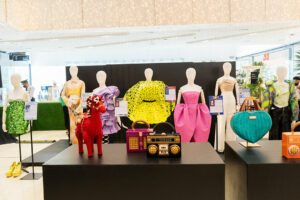How to be good to the planet while still being stylish

FASHION production creates up 10% of humanity’s carbon emissions, and yet 85% of all textiles simply end up in landfills. This according to the website of the Geneva Environment Network, a partnership of over 70 environmentally conscious organizations. It also cites plastics and chemical run-offs as industry byproducts filling up the world’s oceans. This information, plus an exhibit in SM Aura citing the ways fashion should be healing the world might make one think before shopping.
Fashion Forever provides an overview of the emerging fashion industry in Sweden and novel approaches in fashion design, production, and distribution. The exhibit, which opened on Sept. 8, is an initiative of the Embassy of Sweden in Manila, supported by the Swedish Institute, and held in partnership with SM Aura and Swedish clothing giant H&M.
Displays in the exhibits showed off clothes made of recycled materials, while homegrown brands Zarah Juan (a designer using natural materials) and Lily of the Valley (showing period underwear which is meant to reduce the presence of sanitary pads in landfills) also participated.
Notes across the exhibit showed various ways people can reduce the environmental impact of what they wear. Examples include clothes swapping, renting clothes, buying secondhand items, and simply buying better longer-lasting goods.
Dan Mejia, H&M’s Regional Head of Communications and PR for Southeast Asia, laid down the company’s initiatives for sustainability, noting that the company’s initiatives began back in 1997. “It was in 1997 when we created our Code of Conduct and launched a collection called Nature Calling — that’s when we pioneered the use of organic cotton. Today, 100% of the cotton we use in all our garments are either organic, recycled, or from Better Cotton (a non-profit that pushes for better cotton farming practices).”
“We acknowledge that we are part of the problem… not exactly the opening statement you would expect from us, but that is the truth,” said Mr. Mejia. “By we, I refer not only to H&M but to the entire fashion industry. We all have a stake here. Now, we may be one of the largest fashion retailers in the world, but we only represent 2% in the market. To move the industry to be truly fully sustainable, we need the other 98% to join in.”
Swedish Ambassador Annika Thunborg explained in a speech during the event that “The fashion industry is a big polluter and carbon emitter. Far too many textiles end up in trash bins and landfills, regularly thrown away with household waste. Each year, 4.3 million tons of textile waste is deposited or incinerated in the EU.”
After that depressing statement, she cited initiatives of the Swedish government to tackle the issue, which includes Textile & Fashion 2030, a government-supported initiative led by the University of Borås in collaboration with the Swedish School of Textiles, SmartTextiles, Science Park Borås, and the Research Institute of Sweden. This initiative aims to test and study different techniques of sustainable fashion settings of small-scale sustainability advancements and how these can be rolled out on the world stage. Another is the Swedish Textile Initiative for Climate Action (STICA), a network of businesses launched in 2018 that collaborate to reduce their climate footprint. H&M is a participant, as are Kappahl, Peak Performance, Acne, and Filippa K, in collaboration with Sustainable Fashion Academy.
“Upcycling, reusing, and eventually recycling, rather than using up even more virgin resources are some of the ways for the fashion industry to become good for the planet,” she said.
The Fashion Forever exhibit runs from Sept. 8 to 14 at SM Aura. The exhibit will also make an appearance at Cebu Design Week in November. — JLG




